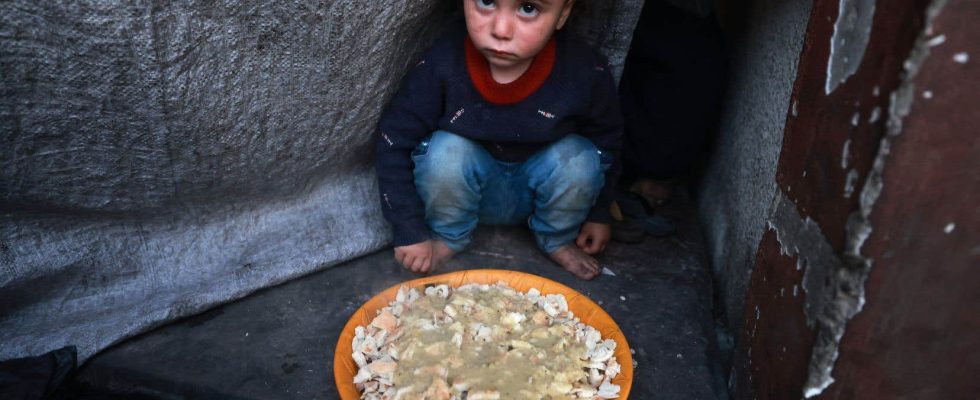The international community is seeking to diversify routes to deliver vital aid to the population of Gaza on the verge of famine and constantly bombarded by Israel, with the head of European diplomacy Josep Borrell denouncing the use of hunger “as a weapon of war “.
In the last 24 hours, at least 88 people have died in Israeli bombings which particularly affected the south of the Gaza Strip, which has been devastated and besieged since October 9 by Israel, the Ministry of Health of the Islamist movement Hamas said on Wednesday.
In the sixth month of the war triggered by a bloody attack by Hamas against Israel, the human toll continues to rise in Gaza with 31,272 deaths, the majority of them civilians, since October 7 according to the same ministry, and the humanitarian situation continues to get worse, with the UN fearing “widespread famine”.
With no truce on the horizon and while aid by land under Israeli control only enters Gaza in dribs and drabs, several countries as well as the European Union have decided on alternative routes, by sea and air.
A first boat loaded with 200 tonnes of food left the Cypriot port of Larnaca for Gaza on Tuesday, using a corridor set up by the EU and several countries. This boat from the Spanish NGO Open Arms, which operates at very low speed, was about 260 km from Gaza on Wednesday, according to the Vessel Finder website.
Cyprus, approximately 370 km from the coast of the Palestinian territory, announced that it was preparing a second, “much larger” load.
Four American army boats left the United States with around a hundred soldiers and the equipment necessary to build a pier and a dock in Gaza for the delivery of humanitarian aid. The trip is expected to take about 30 days and the facility will be ready “within 60 days,” according to American authorities.
Airdrops
For around ten days, several Arab and Western countries including the United States have been dropping meals and medical aid daily into the Gaza Strip, especially the north where the situation is particularly desperate.
But shipments by sea or airdrops cannot replace land transport, insists the UN.
“When we study alternative routes to deliver aid, by sea or by air, we must remember that we have to do it because the usual land route is closed,” said Josep Borrell.
“And starving the population is used as a weapon of war,” he lamented.
According to the Hamas Ministry of Health, at least 27 people died of malnutrition and dehydration, most of them children, in the Gaza Strip, already subject to a total Israeli blockade since the 2007 takeover of this territory by Hamas. Hamas.
The Israeli army announced a “pilot project” which allowed the entry of six aid trucks from the World Food Program (WFP) directly into the north of the Gaza Strip on Tuesday, a first.
But the WFP estimates that 300 trucks of food aid are needed per day to meet the immense needs of some 2.4 million inhabitants, the vast majority of whom are threatened with famine according to the UN.
Since the start of the war, aid has entered Gaza via two terminals on Israel’s southern border, coming from Egypt which keeps its border closed with the Palestinian territory.
Despite international pressure, Israeli Prime Minister Benjamin Netanyahu is determined to continue his offensive against Hamas, considered a terrorist group by Israel, the EU and the United States.
Hamas member killed in Lebanon
“Israel will win this war whatever the cost. And to win it, Israel must destroy the last battalions of Hamas in Rafah,” where 1.5 million Palestinians, the vast majority of whom are displaced, are crowded together, said Mr. Netanyahu.
The Prime Minister vowed to “annihilate” Hamas after the attack carried out on October 7 by commandos of this movement infiltrated from Gaza into Israel.
At least 1,160 people were killed in this attack, most of them civilians, according to a count compiled by AFP from official Israeli sources and some 250 people were kidnapped and taken to Gaza. 130 hostages are still there, including 32 declared dead by Israel.
In retaliation, the Israeli army launched a massive bombing campaign against the cramped territory, followed 20 days later by a ground offensive that allowed its soldiers to advance from the north to the south of this strip of land of approximately 40 km long and 10 km wide.
The head of the UN agency for Palestinian refugees (UNRWA) Philippe Lazzarini denounced a “war on children”, saying that more children have been killed in Gaza in four months of war than in four years of conflict around the world.
Faced with the intransigence of the protagonists, the mediating countries – the United States, Qatar, Egypt – were unable to secure a truce agreement accompanied by the release of hostages, which was hoped for during the Muslim fasting month of Ramadan which beginning this week.
“We are not close to an agreement,” Qatar said.
On the Israeli-Lebanese border, there is no respite from the violence either. On Wednesday, Hamas announced the death of a member of its armed wing, Hadi Moustapha, in a strike attributed to Israel against a car in southern Lebanon in which another person died.
